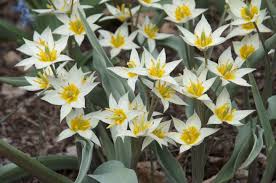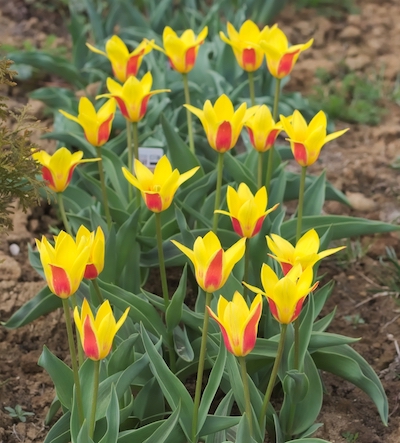After The Thrill Is Gone
By Ray Novitske, Fairfax Master Gardener

Darwin Hybrid Tulips
To learn what happened, we first need to review the life cycle of flowering bulbs. A bulb is a complete plant. A bulb has roots, stem, flower and leaf cells all packed into a small package ready to pop up, grow and bloom in the spring. Once they have finished doing this, they have used up their reserve of food and nutrients. They must manufacture, then store new food supplies in order to bloom again the following year. This happens in the leaves, so it is important to keep the leaves growing healthy with ample nutrients, water and sunlight.
Daffodils
When daffodil bulbs receive an insufficient amount of nutrients, water and light to restore the bulb for the next year, they will not bloom again. If this happens, you might see leaves or fewer smaller flowers in the following year. The trick to getting good blooms again is to ensure they can store up enough food reserves this year.

‘King Alfred’ daffodils
- Do not tie them together or braid the leaves. Because of the reduced amount of sunlight received when this is done, photosynthesis in the leaves is reduced and bulb formation suffers.
- Do not plant daffodils in shade — they need sun.
- Do not cut down the leaves until they start to yellow and brown.
- Be sure the leaves receive water during the times they are producing food for next year. Spring can get hot and dry, especially in our area.
- But don’t overwater or plant in wet areas. Daffodils can be prone to basal rot fungus in their roots and on the bottom of bulbs if placed in swampy wet conditions.
- Fertilize the daffodils after they have bloomed with a 5-10-5 or 5-10-10 fertilizer — one that is low in nitrogen (the first number). High nitrogen fertilizers promote leaf growth but for some reason, reduce root and bulb growth.
- Divide. When daffodils multiply year after year, the growing clump of bulbs compete with each other for nutrients to form bulbs for the following year and stop blooming. Divide them about every three years.
- Plant bulbs in a container, submerged into the ground, then remove them to another location after blooming to hide the leaves and allow them to continue during the spring.
Tulips

Species Tulips
Tulips need a long cool spring (something missing from our climate) after blooming to reform the bulb for another year’s bloom. Most times, a group of leaves will pop up in the following year, and if you wait, they will bloom again in future years — the bulb gets larger each successive year until it is ready to bloom again. I can attest to this. There are a group of tulips under my magnolia tree that bloom about every three years and have been doing so for the past two decades.

Greigii Tulips
- Cut off the blooms as soon as possible after blooming, or cut the flowers and take them indoors to enjoy. Tulips will spend food and energy making seeds, so by cutting off the blooms, the plant spends its resources producing a bulb instead for next year.
- Simply treat tulips as annuals and get new bulbs every year.
- Plant species tulips. The large flowering tulips that we are familiar with are hybrids, or Darwin hybrids. Species tulips, sometimes called water lily tulips or wild tulips, are those more related to the native tulips found in Turkey. They are a little smaller, usually have multiple blooms per stem, bloom a little earlier, but can bloom year after year.
Hyacinths
Hyacinths behave much like the large flowering tulips. My hyacinths will come back every year, but they are not as large and full as their first year of bloom. It doesn’t matter though — the fragrance is enough to keep them in my garden.
Make your spring daffodils and tulips behave like true perennials, blooming year after year instead of only producing leaves. Provide them with a little more care after the flowers have faded, and they will reward you with repeat blooms for many years to come.
References
• Post-flowering Care of Spring Bulbs, Integrated Pest Management, University of Missouri
• Tending your Daffodils, Kelly R. Jackson, Kentucky New Era, 2012
• Spring Bulbs After Bloom, Dr. Leonard Perry, University of Vermont Extension
• Non-Blooming Daffodils, American Daffodil Society
• Species Tulips, Sherry Rindels, Department of Horticulture, Iowa State University Extension
and Outreach